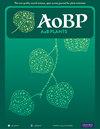"合则立,分则亡":交织是豌豆植物联合行动的证据
IF 2.4
3区 生物学
Q2 ECOLOGY
引用次数: 0
摘要
在生活中,几乎每一种生物都会相互影响。在人类领域,这种互动是联合行动的基础,即两个或两个以上的行为主体为实现共同目标而采取的综合行动。共同意向性是一个理论概念,指的是使这种协调和协作互动成为可能的一整套能力。共享意向性是一种理论建构,指的是促成这种协调和协作互动的一整套能力。尽管共同意向性已成为社会认知研究中的一个重要概念,但围绕其进化起源仍存在争议。对无神经生物的研究是一个尚未探索但有望为这一公开辩论带来新见解的方面。为了填补这一空白,我们在此研究了攀援植物是否能联合行动以实现共同目标,即到达光照处。我们研究了需要攀爬但环境中没有潜在支撑物时相互缠绕生长的豌豆植物。对它们运动的三维运动学分析表明,它们的行为是协调互补的。它们倾向于在时间和空间上协调运动,以实现联合攀爬。通过有意扩展联合行动发生的环境,我们对这一社会现象的复杂性表示了敬意。联合行动领域面临的下一个挑战是提出一种视角,将协调机制与不同类群的进化框架联系起来。本文章由计算机程序翻译,如有差异,请以英文原文为准。
“United we stand, divided we fall”: Intertwining as evidence of joint actions in pea plants
In life, it is common for almost every kind of organism to interact with one another. In the human realm, such interactions are at the basis of joint actions, when two or more agents syntonise their actions to achieve a common goal. Shared intentionality is the theoretical construct referring to the suite of abilities that enable such coordinated and collaborative interactions. Shared intentionality is the theoretical construct referring to the suite of abilities that enable such coordinated and collaborative interactions. While shared intentionality has become an important concept in research on social cognition, there is controversy surrounding its evolutionary origins. An aspect still unexplored but promising to bring new insights into this open debate is the study of aneural organisms. To fill this gap, here we investigate whether climbing plants can act jointly to achieve a common goal, i.e., reaching the light. We examined Pisum Sativum plants growing intertwined when there is a need to climb but a potential support is not present in the environment. Three-dimensional kinematic analysis of their movement revealed a coordinated and complementary behaviour. They tend to coordinate their movement in time and space to achieve a joint climbing. By deliberately extending the context in which a joint action takes place, we pay tribute to the complex nature of this social phenomenon. The next challenge for the field of joint action is to generate a perspective that links coordination mechanisms to an evolutionary framework across taxa.
求助全文
通过发布文献求助,成功后即可免费获取论文全文。
去求助
来源期刊

AoB Plants
PLANT SCIENCES-
CiteScore
4.80
自引率
0.00%
发文量
54
审稿时长
20 weeks
期刊介绍:
AoB PLANTS is an open-access, online journal that has been publishing peer-reviewed articles since 2010, with an emphasis on all aspects of environmental and evolutionary plant biology. Published by Oxford University Press, this journal is dedicated to rapid publication of research articles, reviews, commentaries and short communications. The taxonomic scope of the journal spans the full gamut of vascular and non-vascular plants, as well as other taxa that impact these organisms. AoB PLANTS provides a fast-track pathway for publishing high-quality research in an open-access environment, where papers are available online to anyone, anywhere free of charge.
 求助内容:
求助内容: 应助结果提醒方式:
应助结果提醒方式:


